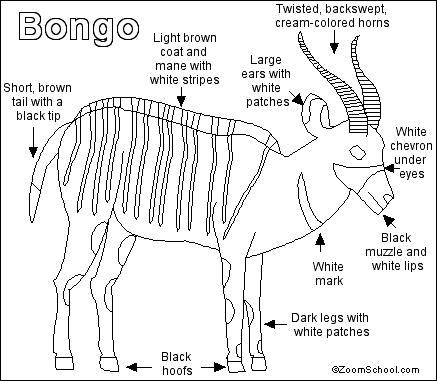
 |
| You might also like: | Gerbil Printout | Old English Sheepdog Printout | Pekingese Printout | Karakul Sheep Printout | Fossa Printout | Today's featured page: Weather-Related Reading Comprehension Activities |
| EnchantedLearning.com More Mammal Printouts | EnchantedLearning.com Bongo or Forest Antelope | Animal Printouts Label Me! Printouts |


Bongos are the only forest antelope that gathers in herds (of about 20 animals). They are fast runners who can also jump very well, but they often go around or under obstacles in the forest. These shy antelopes like to wallow in mud. They are mostly nocturnal (more active at night). Bongos have a 19-year life span in captivity (the life span in the wild is unknown). Bongos were first described by Ogilby in 1837.
Horns: Both male and female bongos have twisted, backswept horns that are up to about 31 in (80 cm) long. Like all horns, they are not shed, but continue to grow throughout the bongo's life.
Anatomy: These graceful mammals are roughly 4 ft (1.2 m) tall at the shoulder; males weigh about 650 pounds and females weigh about 530 pounds. The short, glossy fur is chestnut brown to dark brown, with white to cream spots and stripes; the coat camouflages the bongo in its shady forest environment. A short, bristly, brown-and-white mane runs along the back. Males are larger and darker than females. Bongos have very large ears and big eyes; they use their sense of sight and hearing to detect leopards and other predators.
Diet: Bongos are herbivores (plant-eaters). They eat leaves, shrubs, flowers, young shoots, and grasses. They spend most of their time browsing, using their prehensile tongue to get vegetation, and using their horns to uproot young plants. Bongos have been known to eat burnt wood, perhaps for its salt content.
| Search the Enchanted Learning website for: |